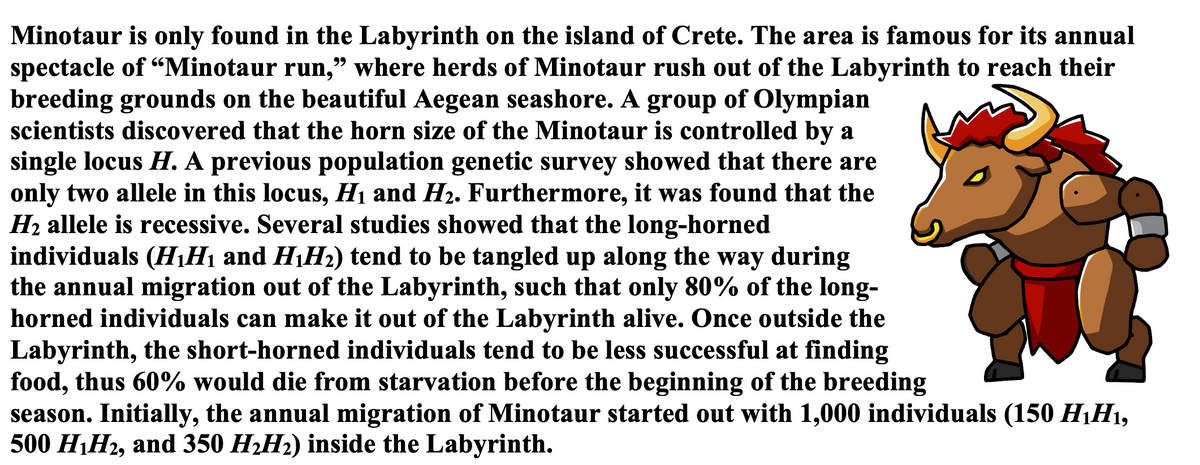Biology: The Dynamic Science (MindTap Course List)
4th Edition
ISBN:9781305389892
Author:Peter J. Russell, Paul E. Hertz, Beverly McMillan
Publisher:Peter J. Russell, Paul E. Hertz, Beverly McMillan
Chapter12: Mendel, Genes, And Inheritance
Section: Chapter Questions
Problem 1ITD
Related questions
Question
What is the average survival rate for the Minotaur when the breeding season starts?
| A. |
0.42 |
|
| B. |
0.54 |
|
| C. |
0.66 |
|
| D. |
0.76 |
|
| E. |
0.83 |
-
Following up on Question 6, assuming random mating, what would be the percentage of long-horned baby Minotaur who are heterozygous at the H locus?
A. 23.5%
B. 25.0%
C. 50.0%
D. 51.5%
E. 68.0%

Transcribed Image Text:Minotaur is only found in the Labyrinth on the island of Crete. The area is famous for its annual
spectacle of "Minotaur run," where herds of Minotaur rush out of the Labyrinth to reach their
breeding grounds on the beautiful Aegean seashore. A group of Olympian
scientists discovered that the horn size of the Minotaur is controlled by a
single locus H. A previous population genetic survey showed that there are
only two allele in this locus, H1 and H2. Furthermore, it was found that the
H2 allele is recessive. Several studies showed that the long-horned
individuals (H,H1 and HH2) tend to be tangled up along the way during
the annual migration out of the Labyrinth, such that only 80% of the long-
horned individuals can make it out of the Labyrinth alive. Once outside the
Labyrinth, the short-horned individuals tend to be less successful at finding
food, thus 60% would die from starvation before the beginning of the breeding
season. Initially, the annual migration of Minotaur started out with 1,000 individuals (150 H,H1,
500 H¡H2, and 350 H2H2) inside the Labyrinth.
99
Expert Solution
This question has been solved!
Explore an expertly crafted, step-by-step solution for a thorough understanding of key concepts.
This is a popular solution!
Trending now
This is a popular solution!
Step by step
Solved in 2 steps

Knowledge Booster
Learn more about
Need a deep-dive on the concept behind this application? Look no further. Learn more about this topic, biology and related others by exploring similar questions and additional content below.Recommended textbooks for you

Biology: The Dynamic Science (MindTap Course List)
Biology
ISBN:
9781305389892
Author:
Peter J. Russell, Paul E. Hertz, Beverly McMillan
Publisher:
Cengage Learning

Human Heredity: Principles and Issues (MindTap Co…
Biology
ISBN:
9781305251052
Author:
Michael Cummings
Publisher:
Cengage Learning

Biology: The Dynamic Science (MindTap Course List)
Biology
ISBN:
9781305389892
Author:
Peter J. Russell, Paul E. Hertz, Beverly McMillan
Publisher:
Cengage Learning

Human Heredity: Principles and Issues (MindTap Co…
Biology
ISBN:
9781305251052
Author:
Michael Cummings
Publisher:
Cengage Learning